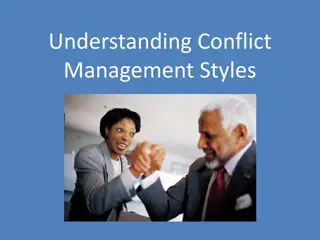Conflict Management Strategies and Negotiations in the Workplace
This chapter covers conflict resolution, negotiations, and labor relations in the workplace. It includes stages in the conflict process, conflict escalation, approaches to conflict resolution, negotiation techniques, and strategies for managing and preventing conflicts at work. Additionally, it explores the history of labor relations in Canada and the impact of collective bargaining agreements on conflict management.
Download Presentation

Please find below an Image/Link to download the presentation.
The content on the website is provided AS IS for your information and personal use only. It may not be sold, licensed, or shared on other websites without obtaining consent from the author. Download presentation by click this link. If you encounter any issues during the download, it is possible that the publisher has removed the file from their server.
E N D
Presentation Transcript
CONFLICT MANAGEMENT CHAPTER 2: CONFLICT RESOLUTION, NEGOTIATIONS, AND LABOUR RELATIONS Unless otherwise noted, this work is licensed under a Creative Commons Attribution-NonCommercial-ShareAlike 4.0 International (CC BY-NC-SA 4.0) license. Feel free to use, modify, reuse or redistribute any portion of this presentation.
Learning Outcomes Upon successful completion of this chapter, you will be able to: Summarize stages in the conflict process. Recognize characteristics of conflict escalation. Describe common approaches to conflict and explain when to use them. Explore common strategies for preventing and managing conflict at work. Define negotiations. Contrast distributive and integrated approaches to bargaining. Summarize the steps in the negotiation process. Demonstrate awareness of the history of labour relations in Canada. Describe how the collective bargaining agreement impacts negotiation and conflict management in the workplace.
2.1 The Conflict Process I The most commonly accepted model of the conflict process was developed by Kenneth Thomas (1976).
2.1 The Conflict Process II Conflict Escalation
2.2 Approaches to Conflict I Every individual or group manages conflict differently. In the 1970s, consultants Kenneth W. Thomas and Ralph H. Kilmann developed a tool for analyzing the approaches to conflict resolution. This tool is called the Thomas-Kilmann Conflict Mode Instrument (TKI) (Kilmann Diagnostics, 2017).
2.3 Conflict Resolution Strategies I Common Strategies that Seldom Work Nonaction Administrative Orbiting Due Process Nonaction Secrecy Character Assassination
2.3 Conflict Resolution Strategies II Strategies for Preventing and Reducing Conflict Strategies for Preventing Conflict Emphasizing organization-wide goals and effectiveness Providing stable, well-structured tasks. Facilitating intergroup communication. Avoiding win-lose situations
2.3 Conflict Resolution Strategies III Strategies for Reducing Conflict
2.4 Negotiation I Negotiation is the process by which individuals or groups attempt to realize their goals by bargaining with another party who has at least some control over goal attainment. Image by Gerd Altmann from Pixabay
2.4 Negotiation II Approaches to Bargaining Distributive bargaining is win-lose or fixed-pie bargaining. Integrative bargaining, is referred to as a win win approach.
2.4 Negotiation III Phases of Negotiation
2.5 Labour Relations I According to Statistics Canada (2022), 30.9% of employees in the Canadian workforce are unionized employees. A labour union, or union, is defined as workers banding together to meet common goals, such as better pay, benefits, or promotion rules.
2.5 Labour Relations II Collective Bargaining Collective bargaining is the process of negotiations between the company and representatives of the union. The goal is for management and the union to reach a contract agreement, which is put into place for a specified period of time.
2.5 Labour Relations III The Collective Bargaining Process
2.6 Key Takeaways The conflict process consists of four stages Conflict can often escalate in similar patterns. The Thomas and Kilmann model identifies five approaches to conflict Ineffective conflict resolution strategies include nonaction, administrative orbiting, due process nonaction, secrecy, and character assassination. Negotiation is the process by which individuals or groups attempt to realize their goals by bargaining with another party who has at least some control over goal attainment. Different negotiation strategies include the distributive approach and the integrative approach. Negotiation consists of five phases Collective bargaining is the process of negotiating the contact with union representatives. The collective bargaining process can take time.























